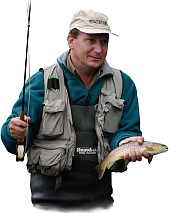Charles Jardine was privileged to watch a Czech Nymph master at work on the Derbyshire Derwent. Here's what he absorbed from an impromptu masterclass.
We bandy superlatives around nowadays with the sort of flippant abandon as to devalue their true meaning. It's odd really, because when someone of a very rare and special skill comes along, a true and deserving case for the use of these adjectives, where does one go?
Believe me, I have fished with some masterful anglers down the years, but there are few that can quite measure up to the consummate skill and intuitive guile and craft displayed by Jiri Klima when he visited the Derbyshire Derwent late this summer.
Jiri is without doubt one of the best readers of a stream I have seen, save perhaps Roman Moser, our own Ollie Edwards and a few others: they are indeed a precious few. Each displays that rather unnerving, uncanny understanding of the world below the surface: one where micro-currents can determine fish position to a matter of a foot or two - perhaps even inches; indeed, they understand minutely, the very specific need of certain flies in certain areas to fish effectively in the prime feeding areas. Most of us pitch and hope.
I think too, there is a similarity in fly tying between the two continental river gods: Moser and Klima. Both opt for roughhewn simplicity and both would rather spend time fishing their patterns rather than tying them. Each sees the river as a blank canvas and flies as the build up of colour.
I believe that day in late summer along the banks of the Derwent will live long in the memory of those that gathered to watch, originally me to tie and cast, but ending up being the lucky recipients of a masterclass by Jiri because of a chance phone conversation with a mutual friend, Pavel Adamovsky. Pavel mentioned that Jiri was visiting the UK. A few hasty calls later and there we were: on the banks of the Derwent at Cromford at the court of 'king' Jiri.
So just what separates the likes of Jiri from other anglers?
Actually it's hard to define. The Czech style of river fishing is so well documented in the past pages of this magazine it would daft to revisit these in detail, but Jiri does do things a little differently. But what makes his style different? I think simplicity is the key. Simplicity, and a very careful attention to tackle detail. And the flies: Wow! The flies.
But first Jiri's kit.
A Sage 9ft 6in #6 for the bigger rivers, a 9ft #5 for smaller streams and a little 8ft #4 for brooks - Czech nymphing with an eight footer! Well Jiri seems to think it works and who are we to argue? The lines are floaters, of course, and the leader material is Stroft. This supple polycarbonate has immense strength for such a small diameter and, having used this brand for some months now and revelled in its dry fly possibilities as well as nymph fishing virtues, wish, oh wish that someone would bring it into this country. You can find it like a rash all over the continent, but here: pah.
Now, the flies. Again, simplicity reins supreme, but to meet the needs, the very specific needs of his style, Jiri has designed and crafted not just the materials but the hooks to support everything, the special lead-moulded hooks painted to look eerily like jungle cock cheeks. Lead moulded hooks in various sizes that plummet like stones to their desired level - and do so in a very svelte way indeed, fluorescent painted hooks, printed vinyl shell backs and a host of other innovative components to make the flies as deadly as they are simple to tie.
But you can have all the finest materials in the world but they don't count for a jot if you don't know how to best use or put them together.
Take the Czech Nymph for instance. Yes, I know; everyone knows how to tie these. Or do they?
First: Jiri only weights the rear part of the hook - and when using, say, a grub hook will tend to place the lead around the area that prescribes this bend, then up to a point half way along the shank, leaving the area down from the eye free to finish off the pattern. The reason for this is to provide a better entry and 'cut' through the layers. I didn't know that: did you?
Second: The Czechs put, by comparison to us in this country, remarkably little weight on their patterns. Relying instead on the actual design and shape of the pattern also the choice of materials - to carve its deadly swathe through the layers to the fishing zone. I didn't know that either.
Third: When tying in his deadly shell backs (a sort of patterned vinyl back) he always almost finishes the fly, then, with the nylon rib still hanging from the hook bend attaches the shell back strip at the head and secures this down with turns of nylon rib. Jiri maintains this is far quicker and leaves a far smaller build of thread at the eye. New to me.
Fourth: He always rolls his dubbing, usually an Antron mix of sorts, into a tapering point, then ties this in at the position he wants and then folds this tapered dubbing section around his thread and "noodle" dubs as usual.
Jiri's weighted flies represent all manner of underwater life, including grubs, larvae, pupae and fry.
In order to meet his own critical criteria Jiri has gone out and either sourced the product or made it himself. This in turn has led to a great deal of innovation and individuality.
But, as is so often the case it's not what you fish, it's how you fish it.
The leader flabbergasted us all. Jiri peered at the water he was to demonstrate on. Selected his 9ft 6in and some 2kg (4.51b BS) tippet material measured off about two metres, tied in a . dropper with a further half a metre and that was it. A leader of about five feet, two flies: Done! What?
Everyone, it seems, uses way too longer a leader in Jiri's opinion and three flies do not work as well as two. So, onto the leader went the heaviest - a gold headed Hare's Ear on the middle - and a Rhyac pattern on the point. The whole thing seemed ridiculous: such a short leader. Mad.
First swing down in the now-familiar toss upstream - drift - then kick and strike as it hovers on its fullest downstream extent in the fished out position. Guess what? Yep: a grayling.
Second cast a brown trout - case proven. Well, it was to us. Jiri went on to catch in excess of 15 fish in a matter of an hour or so from the water that normally gives up her fish fairly grudgingly. It was a magnificent and apposite demonstration on just how fishing can be uncomplicated and tackle-jargon free, as long as a modicum of grey matter goes into the rest of it!
Subsequently, I have tried this shortened leader method and stuck to two flies and it has been utterly lethal. Possibly it has caught me fish that otherwise would have eluded me.
It will come as no surprise to learn that Jiri is a key part of the Czech national squad that has, in recent years, featured so prominently in all major competitions: heavens, they are even beginning to beat the Brits at their own stillwater game.
The small little 'eyed' fly and hooks are testament to the growing trend of Continental fly fishers to switch their very considerable angling prowess to the world of lakes. Without doubt the little jungle cock daubed weighted head has proven deadly when stalking and also for providing the sort of 'in-between' weight needed to straighten and 'kick' down a team of nymphs through the layers when nymphing on reservoirs and larger lakes.
But like all great anglers - ours here in the UK, too - Jiri's mantra is 'simplicity'. The less complicated it is, the more one is going to concentrate on the actual fishing.
Now I am not going to suggest and would hate to give the impression that, verything that we do is redundant and the Klima way is sacrosanct. Far from it.
There are materials uses which I feel could be bettered - the Antron that he employs being one. Nevertheless, he is an innovator and we need anglers and fly tyers who push boundaries back, so that we can in turn feast on this rich fare - perhaps even expand and use this raw material and base of innovation to spring into other areas entirely and ultimately expand the concepts and horizons. Actually, it's called progress. Certainly the way that the foregathered watching Jiri tie flies at Cromford salivated, there is room in the groaning shelves of our fly-tying emporiums for this range of products. Of course what one cannot guarantee is that the products will turn you into a river god: but you never know.






















